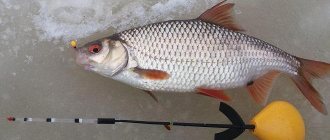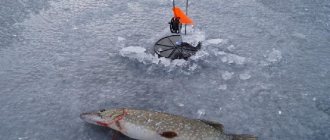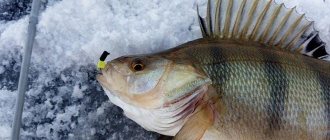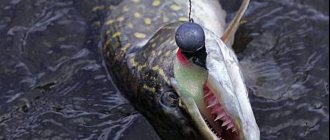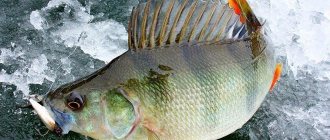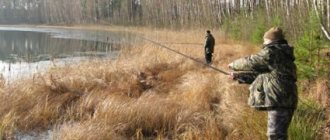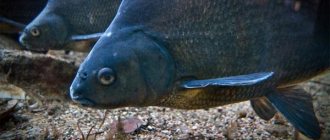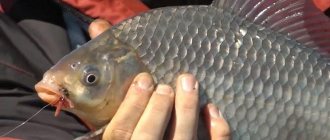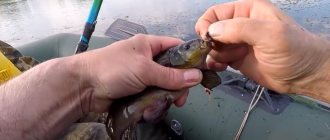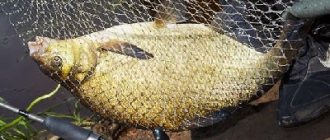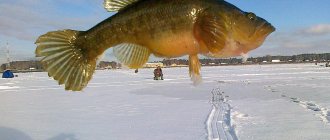There is no single recipe for successfully catching crucian carp on the first ice - the silvery picky fish in various reservoirs during this period can either actively feed or stand passively in the silt, gradually falling into suspended animation. It all depends on the regional characteristics and conditions of the reservoir.
In those places where crucian carp are quite active all winter, fishing on first ice will most likely be successful. In some places, during the period of ice formation, even zhor can be observed. Let's take a closer look at how to catch crucian carp on the first ice, what tactics and gear are best to use.
Winter crucian carp in the first ice
In winter, crucian carp goes into suspended animation only in those reservoirs where there are conditions for this - the presence of thick silt at the bottom, the absence of a current. Usually these are oxbow lakes, peat bogs, and ponds that are closed from the rest of the drainage system. In rivers, reservoirs and ponds with a hard bottom and a small amount of bottom sediments, crucian carp do not sleep in winter - they are forced to lead an active lifestyle, and for this they need to eat.
In some reservoirs there is a well-known schooling differentiation of this fish. Simply put, the behavior of individuals from different schools of crucian carp can vary greatly even within the same reservoir. At the same time, some flocks are quite passive in winter, burying themselves in silt or standing in secluded places without feeding.
Others periodically search for food and migrate slowly, in search of places more suitable in terms of food, oxygen content and water temperature.
Read more about the nuances of catching crucian carp from ice.
To fish for crucian carp on the first ice, you need to take into account the latitude of the region - the further south you go, the more likely it is that silverfish are caught in winter, and even more so on the first ice. It is important to understand the rule - everything depends on the reservoir and its conditions.
Due to the high adaptability of this fish, its behavior can vary greatly in different bodies of water. Therefore, when going to an unknown place, you need to make inquiries to see if crucian carp is actually caught in this reservoir from the ice. You can do this on local fishing forums or ask fellow fishermen.
What to use to catch crucian carp from ice
To catch crucian carp from the ice, use a winter fishing rod with a nod or a winter float fishing rod. It is better to use these gears simultaneously. In promising places, “cast” float rods and continue fishing the area with a winter fishing rod equipped with a jig.
After the onset of freeze-up, the activity of crucian carp noticeably decreases. But, if you throw bait near its habitat (entrances and exits from holes), then usually the fish does not refuse additional food. When fishing for crucian carp from ice, the likelihood of a bite increases on sunny, windless days.
Ice safety
The first ice is dangerous; when going fishing, you must always remember about the safety of life and health. The generally accepted meaning is that you cannot go out on the ice until its thickness reaches 5 centimeters . A necessary piece of equipment during this period is an ice pick for tapping the surface in front of you. If the ice does not break through with one medium-sized blow, you are good to go.
We try to follow the tracks, along already trodden paths, avoiding areas with frozen air bubbles, wet snow and yellowness . You need to have with you rescue ropes with spikes , with the help of which it is much easier to get out of the hole. Detailed article about safety precautions when moving on first ice:
https://podlednik.ru/lovlya_zimoj/rybalka/bezopasnost-i-pravila-povedeniya-na-ldu
Safety precautions when moving on ice
When going fishing on first ice, you need to follow safety precautions. Among them:
- The ice thickness must be at least 5 cm;
- the presence of an ice pick is mandatory;
- move along well-trodden paths;
- avoid areas with wet snow/yellow conditions;
- avoid places near reeds (the ice here is not strong);
- do not go out on the first ice alone;
- carry a fishing box on one strap (it will be easier to remove it in case of falling through the ice);
- It is not recommended to fish in groups in one place.
Winter fishing on ponds and rivers is an interesting and promising activity. The main thing is to prepare for it correctly. The gear must be reliable, balanced, the bait must be fresh, and the groundbait must be attractive. It is better to drill holes at a distance of 10–20 m from each other, observing the rules of behavior on ice at the beginning of winter.
Possible behavior patterns of crucian carp at the beginning of freeze-up
Crucian carp easily adapts to a variety of environmental conditions - it is this factor, together with the characteristics of reproduction, that causes the viral spread of the silver glutton. Hence the myth about the capriciousness and unpredictability of this fish.
In fact, silver crucian carp is rather not capricious, but versatile, exhibiting very different patterns of behavior in certain environmental conditions, adapting to them. Therefore, including the first ice, there can be many possible behavior patterns of this fish - depending on the reservoir and specific external conditions.
- In stagnant, silted reservoirs in the north, crucian carp hibernate by the time of the first ice. In some ponds - as early as November, in open water. In others - later, in December, but on the first ice they are still actively caught, accumulating fat reserves before a long hibernation.
- If freeze-up happens abruptly, and water bodies are frozen with ice overnight, crucian carp usually stops biting for several days, as it adapts to the new reality. However, after 4-5 days the fish becomes more active and begins to feed. If the ice becomes slow, then freezes, then melts again, there will most likely not be any sharp changes in feeding intensity.
- The bite or lack of bite is influenced by many factors, in addition to the timing of the formation of the first ice - flow, food supply, currents, water temperature and oxygen content, changes in atmospheric pressure and weather. Therefore, all sorts of biting calendars are useless - you should focus on knowledge of specific reservoirs and the characteristics of crucian carp behavior in them.
- General trends - you need to search deeper than in summer, use thin gear and small baits in some places, but not in other places. The starting point for crucian carp for the first ice is to figure out for yourself whether the fish are now active in this body of water or not. If it is active, we look for it in the shallows, near a cut of vegetation, in the reeds. If it is passive, we examine the holes and snags.
- In the south, during warm winters, the ice disappears and then returns. Therefore, as such, the period of first ice repeats throughout the winter, and the deep winter, familiar to the fisherman of the middle zone, is not observed. In such places, crucian carp are caught quite actively all winter with varying intensity. Moreover, in the southern regions, silver crucian carp is the main trophy for winter anglers.
- The bite of crucian carp in small reservoirs after the formation of ice may fade due to the activation of the pike's appetite. As you know, garrisons eagerly await the first ice to hunt for the toothy fish. However, if there are no huge pike in the reservoir, and the crucian carp is large, most likely, the predator’s activity will not affect the silver’s bite.
The common rule that at the beginning of winter the activity of crucian carp is higher does not work in all reservoirs. In some places, silverfish are not caught in the first ice, but then, over time, their bite gradually intensifies. Article about fishing for crucian carp in December:
There is only one conclusion from all of the above - the fisherman needs to know that it is in this particular body of water that crucian carp are caught from the ice in winter in principle, and do not go into suspended animation in November. Then, depending on the year and the speed of cooling, you can count on a good bite of the silverfish on the first ice, even in muddy ponds, in which it will fall asleep later, closer to the dead of winter.
In most rivers and reservoirs, active crucian carp can almost always be found, along with the fact that some schools of crucian carp still behave passively, settling in holes or snags. The fisherman's goal is to find active fish that are looking for food and moving around.
Life cycle of crucian carp during the first ice period
In many reservoirs at the beginning of winter, crucian carp activity may be higher than in open water before freeze-up. This is also typical for other types of fish: perch, roach, bream. Crucian carp strives to accumulate fat reserves before hibernation , into which it falls in some reservoirs, or before switching to a semi-passive lifestyle, which it has to lead during the deep winter.
In stagnant reservoirs, crucian carp can be active only for a few days after freeze-up; where there is at least some current or underwater springs, the crucian bite can last much longer.
How to catch crucian carp on first ice
The tactics of catching crucian carp on the first ice are based primarily on the strategically correct choice of location. Even hatching on bait should be done in those waters where crucian carp are, in principle, present. You also need to take into account daily biting patterns.
In some reservoirs, the hybrid is better caught during the day, in others - at night. With a light color, for example, crucian carp can be caught in coastal bushes in search mode, and with a dark color - at certain points with bait. Any fishing begins with searching for promising fishing spots.
Lures and lures for catching crucian carp from ice
Winter jigs are used to catch crucian carp from the ice. Their diversity allows you to choose models for any winter fishing conditions. There are no special jigs for crucian carp. It is important that the behavior of the bait is similar to the behavior of bottom insects. Models such as:
- Devil;
- Witch.
Finding a fishing spot
The eternal question of the winter road is where to look for crucian carp on the first ice. Let's consider some general patterns and trends in the search for silverfish in the first ice on reservoirs of various types. Prospective sites for this fish may differ radically. In some places, silty shallow waters with vegetation will work - the same places as in the summer.
In others there are deeper areas, a border of reeds or submerged snags. One thing is true - crucian carp avoids areas with a flat sandy bottom. On such peals the silverfish can be found only in the spring, during the period of mass spawning migration.
Now the fish gravitate to points with any type of cover - snags, vegetation, drops, even small folds on the bottom. There are always some aquatic invertebrates here, dracena shells, bloodworms, leeches, which the crucian carp feed on.
In the rivers
Large crucian carp in rivers usually gather in pits when it gets colder, but not in the current, but where there is practically no current - quiet pools, calm reverse currents, deep-water reaches. First of all, in terms of the first ice, it is not just the depths that are interesting, but the differences in them, the entrances and exits from holes, flooded snags, edges and other anomalies.
However, as always with crucian carp, this is not a rule. You can still find silverfish in some reservoirs at the beginning of freeze-up, in relatively shallow summer places or near reed thickets. In large rivers, towards the first ice, the hybrid often moves to depth, where its food preferences and lifestyle at this time coincide with bream, adult silver bream and carp.
In small rivers we look for silverfish, primarily in deep-water areas under trees, among snags and large roots, as well as in deep pools behind the cape, in a weak current. If in summer a large hybrid can be successfully caught on a stream in the grass, now it saves energy, preferring quiet places.
We check the first ice and shallow waters, especially in good weather - crucian carp still go out into the grass to feed and bask in the sun. The silverback does not hibernate in rivers, since the oxygen regime in them is normal all winter.
First ice on the ponds
To successfully catch crucian carp on the first ice on a pond in December or November, you first need to know the features of this reservoir and take into account regional nuances. Even on muddy peatlands overgrown with mud, where the silverfish hibernates, in the first ice conditions a zhor can occur - the last dash of the fish to accumulate winter reserves before suspended animation.
At the same time, on ponds where crucian carp are caught all winter, with the formation of ice, a lull in the bite can be observed - the crucian carp adapts and adapts to new conditions. In any case, if the features of the reservoir are unknown, before fishing, make inquiries with the locals. Crucian carp is usually caught on the first ice in the pond, as in other bodies of water. However, the fisherman needs to find the exact place, choose the right gear and bait.
- On many ponds, part of the crucian carp herd is passive, accumulates in the winter mooring area and does not feed. However, some individuals, sometimes in large numbers, continue to search for food. Such crucian carp are a target for an angler, but you need to look for active fish in other places - in the grass, near the shore, in snags.
- Passive crucian carp usually stands in natural depressions, on the riverbed or under the edges, behind dumps, near underwater springs and flooded trees. If you accurately find a school and throw the bait right under your nose, you can even tempt sluggish fish to bite.
- We catch passive crucian carp even in the first ice according to all the rules of the deep winter - thin tackle, small jigs and hooks, sluggish play, moving on the bottom. We are looking for active fish, not staying in one place for a long time.
You shouldn’t rely on bait – it’s better to look. And if you add bait, do it little by little, very carefully. In many ponds, crucian carp in winter not only does not respond to complementary feeding, but, on the contrary, moves away from the hole. In such cases, the only feeding option is a small pinch of bloodworms - directly to the bottom, with a small winter dump truck.
Lakes and reservoirs
In reservoirs, oxbow lakes and lakes, catching crucian carp on the first ice follows the same principles. It all depends on the terrain conditions. The silverback can stand both at depth and actively search for food on the reed strip and the borders of vegetation thickets. We focus on active search. Sitting on bait during this period is unlikely to bear fruit.
We also check deeper water areas adjacent to the shore - holes, snags, dumps into the riverbed, areas with springs. In reservoirs, the bite on first ice is affected by changes in water levels. Usually, when the level drops, when coastal thickets are exposed, the bite intensifies, since deposits of organic matter with bloodworms in the coastal zone become inaccessible to the fish.
On large reservoirs, a paced search is important, especially if the fishing area has not been studied. In vast areas of water, crucian carp can be anywhere, but most likely - in the coastal zone or at depth next to it. Here you need to look for any underwater irregularities or colonies of shells, islands of mud and algae.
You may have to use bait to collect and place active fish on the spot. We use only fine winter mixtures of a dark color, without a strong odor , with the addition of boiled millet or bloodworms.
Winter tackle for catching crucian carp
For catching crucian carp in winter, winter fishing rods with a nod are mainly used. To do this, take an ordinary winter fishing rod with a very soft and sensitive guard, since the fish bite in winter is very careful and is often quite difficult to notice.
A fishing line with a diameter of 0.08-0.16 mm is suitable. In fact, a line with a diameter of 0.08 mm would be preferable, since the water is very clear in winter and crucian carp are cautious. Such a fishing line, when fished carefully, copes with its task perfectly and does not alarm the fish at all. The main thing is not to force things and when pulling the crucian carp out of the hole, help with your hand.
The tackle can be set motionless and wait for a bite. Thus, the crucian carp is attracted by the fact that a bloodworm is attached to the jig. Or you can make a light game with the bait - it should be the lightest and smallest vibrations with long pauses. You can simply periodically raise the bait ten centimeters and lower it back into place to attract the crucian carp with movement. Or, from time to time, make short oscillations with a small amplitude, again so that the fish notices your bait faster.
Active play will have a negative impact on the bite. Do not forget that this is not the best period for fish and you should not try too hard to attract its attention. Now the fish is uncomfortable, its metabolism is slow, its reaction is inhibited, it is more difficult for it to move and react to the environment. But still, crucian carp are tempted from time to time by fishermen’s bait, the main thing is to offer it correctly.
Active and passive tactics
Tactical options for the first ice, used depending on the conditions of the reservoir and fish activity:
Fast exploratory fishing, searching for areas where crucian carp accumulate in the best feeding areas, as well as chasing a constantly moving school. On large bodies of water, we first drill holes in large increments, 50-100 meters, in order to find fish in principle. After identifying the area where the fish is located, we drill a square in increments of 10-20 meters.
- Targeted fishing of the water area in a checkerboard pattern, from shallows to depth. More applicable on small ponds and canals.
- Spot fishing of the most promising places based on external landmarks - on small rivers.
- Passive fishing - 2-3 groups of holes at a distance, each one is fed. Then the angler hatches the crucian carp with fishing rods or a jig, periodically checking the points. This tactic of waiting for bait will work if the crucian carp moves and does not stand still.
- The best tactic for the first ice in an unfamiliar place is a semi-active way of searching for crucian carp, when holes are drilled in a promising square with a step of 10-20 meters, but the fisherman must spend at least 20 minutes on each. Semi-passive crucian carp does not always approach the bait immediately, you need to wait.
- The same tactic works great when the silver is standing absent-mindedly over a large area. In this case, if after catching 2-3 fish from a point the biting stops, we move on. Sometimes it is worth drilling a hole at a distance of a meter from the previous one - again 1-2 crucian carp.
So we move on, as if we were harvesting from the garden. It’s convenient to work with 3-4 fishing rods per stand at once - we place the gear at once in 1-3 meter increments so that you can see everything at the same time. It is more convenient to use nods, since the floats in widely spaced holes are not visible at the same time from one point. From time to time we lift each fishing rod and tap the bait on the bottom.
When the hunger starts, we’ll leave one fishing rod and fish with it. And so a large area is fished. Gradually we move one fishing rod to the next hole to fish the next area. For such tactics, you need a prepared sharp ice auger, since drilling and moving is sometimes required constantly.
If the reservoir is not rich in shelter, then under one snag or a flooded tree, in a lonely hole with shells, a huge number of crucian carp can accumulate at the first ice. If you find such a place, you can fish from one hole for the entire fishing trip.
Reservoirs and lakes
On the first ice you should do everything almost the same as on ponds. It’s better to focus on an active search, but you also need to check the holes and flooded snags. You have to constantly move and search along the coastline or on uneven bottoms. To collect actively feeding fish, you can use bait, preferably dark in color, matching the color of the bottom and without unnecessary odors. A semi-active fishing method, when holes are drilled 10–20 meters apart, is the most promising tactic on the first ice. You don’t need to do a lot of them, spend 20 minutes on each one and, if there are no results, move on and do new ones.
Sometimes the crucian carp stands scattered at a great distance, in this case this tactic will also work, the bite will take place little by little, 2 - 3 individuals, then it’s worth moving to the next place and trying again, but in this case there will not always be a transition to long distances, sometimes A couple of meters is enough. Types of winter gear.
Lure
Bait for crucian carp during the first ice is used in those reservoirs where it is known for certain that silverfish react to it. On an unfamiliar body of water, it is better to rely on searching, since feeding on the contrary can ruin everything.
At depths of up to 1.5 meters without a current, you can throw fertilizer directly into the hole, dry or liquid from a bottle. At great depths with current, use a dump truck to the bottom. The composition and consistency of the mixture depends on the tastes of the crucian carp in that particular place:
- Store-bought special winter bait or dark feeder fine mixtures, without a strong aroma.
- Homemade bases from breadcrumbs, ground cookies, gingerbread, sunflower cake or fried seeds.
- If the crucian carp is actively feeding, add a feed component. It can be boiled millet, pearl barley, but better - bloodworms, maggots, chopped worms. Add a little - fish in cold water quickly fills up.
- We work extremely carefully with dips and flavorings in winter, including the first ice. Any strong smell may not only not attract, but also scare away the fish. Summer batches with kerosene or WD-40 do not work now - we focus on natural weak aromatics. It can be ground hemp grains, flax, cocoa or weak garlic.
- Sometimes crucian carp respond well to turbidity and odor when milk powder is added to the feed.
On large reservoirs, if there is a fish on the first ice, you can put a school of crucian carp on the point with a large amount of bait. In the south it is usually boiled millet and cake; in the middle zone it is dark, small winter or feeder bait with feed bloodworms. A powerful feeding spot will work if there are a lot of fish in this place. and she moves. Read more about the correct winter bait for crucian carp.
What do crucian carp bite on the first ice?
The traditional bait for any winter fish is bloodworm. If you want to experiment, we try maggots, worms, sometimes we use semolina or dough. However, the best bait that always works is bloodworms. When there is a good bite, we plant several larvae, perhaps with a buncher. For passive fish we work with small hooks or jigs with the addition of one or two bloodworms.
In places where small roach or ruff do not allow the use of bloodworms, we use maggot or semolina. We change the bait more often, especially during passive biting. Often the silverback will take fresh bloodworms and ignore old and soaked ones. The bait on the hook should always be fresh and tempting.
What do crucian carp bite on in the first ice?
In the first ice conditions, baits of plant origin are ineffective. During this period, it is better to give preference to the following baits, which work flawlessly for crucian carp:
- bloodworm;
- muckworm;
- burdock moth larva;
- maggot;
- Sandwiches made from bloodworms and maggots.
If the bite is passive, then small hooks or jigs should be used in tandem with bloodworms. Maggot or semolina will help save the situation when ruff and small roach are present in the fishing area. The main principle in successful fishing is fresh bait with an attractive smell.
Weather and time of day
There is no single recipe for the weather for crucian carp - we rely on local patterns and characteristics of the reservoir. All these cool calendars are a myth and fiction. On some reservoirs the bite is better in frosty and sunny weather, on others - in cloudy and quiet weather. In different places, crucian carp can be caught better or worse both during the day and at night, including in the first ice.
It has been noticed that at night it is better to rely on the tactics of hatching with bait, however, a promising point should be looked for before dark using the search method. Many factors can affect the bite on the first ice:
- Wind, precipitation, atmospheric pressure surges.
- Whether the pond is covered with snow or not.
- Change in current or water level.
- Migrations of the food supply.
- Air temperature – thaw or frost.
Different bodies of water have individual daily rhythms. In some places, crucian carp take better in the morning, in other places - in the afternoon or evening. When fishing at night, it can peck steadily all the time, other times - in the evening or early morning, with a pause at midnight. On large reservoirs, trophy crucian carp per kilogram are caught more often in the early morning hours.
On large rivers or reservoirs, you need to remember the biting points for crucian carp by tracking them using a GPS navigator or leaving landmarks so that you don’t waste time searching next time.
The characteristics of each body of water determine the behavior of fish in it. Any weather fluctuations or daily rhythms can only be tied to a specific location. In other water areas, the observed nuances simply will not correspond to reality.
Even in one place, due to weather changes, the internal rhythms of crucian carp change. Today, during the thaw, it was biting well all day - tomorrow, in a snowstorm and blizzard, exits may be at sunset or at dawn, and vice versa. Only with multiple visits to one place can a certain picture of the peculiarities of the bite emerge.
Time and weather
Traditionally, ice appears in central Russia in late November – early December. December is the main month for catching crucian carp on the first ice. In cloudy weather, crucian carp bite better , and the bite can be stable throughout the day. Night fishing can be very effective, and in the dark the likelihood of catching trophy specimens increases. In clear weather, it is better to catch crucian carp immediately after dawn and before sunset. A thaw for catching crucian carp is the optimal weather conditions; in cold weather it bites much worse.
Expert opinion
Knipovich Nikolai Mikhailovich
Zoologist, hydrobiologist. I am interested in fishing at a professional level.
Interesting! It has been noticed that in frosty weather crucian carp moves to deeper places, and in the thaw it is better to look for it in shallow water. Obviously, this is due to changes in atmospheric pressure.
Tackle
Depending on the type of reservoir and local conditions, various gear and fishing methods are used to catch crucian carp on the first ice and during the rest of the winter:
- Fishing rods for stationary fishing, with a nod or a float.
- Active jig for the game.
- Mothless.
- Heavy bottom gear, for currents and great depths.
More often, fishing rods with a float or nod are used. The float tackle is installed on the bottom; this method works well when hatching with bait. A more active and universal method is nodding winter tackle. Such a fishing rod, in addition to stand-up fishing, allows you to fish with an active game, as well as place several tackles at a distance of 3-5 meters with semi-passive tactics with constant movement, when it is important to monitor all alarms at the same time.
The disadvantage is that you need to constantly clean the holes from slush so that the fishing line does not freeze into the ice. Otherwise, you may miss the bite. For fishing rods with a float, you can clean the holes less often. Article about winter gear for crucian carp:
Balalaika with nod
Stationary fishing rods
Any fishing rod for winter tackle for crucian carp is suitable - a store-bought fishing rod with a reel, a balalaika, a filly or a homemade version of the design. This question is not for everyone - as long as it is convenient for the fisherman. More important is the equipment itself - fishing line, float or nod, hooks and jigs.
A universal option is a fishing rod with a nod, which can be used to fish both stationary and to play along with a jig during the process. The main element of the equipment is the nod. The nod is loaded in accordance with the weight of the jig or sinker in order to sensitively register bites on the rise.
For passive fish, it is even more important to fine-tune the load capacity of the guard - otherwise the crucian carp will spit out baits that are too heavy. The fishing rod is adjusted so that the principle of compensating the weight of the bait with an unbending nod works. Read more in an article about setting up a fishing rod with a nod.
The gatehouse form can be made from available materials - lavsan, x-ray film, watch spring metal, boar bristles, carbon fiber, or you can buy a ready-made version in the store.
If float tackle is used, then fine tuning is also needed. In this case, the function of unloading and signaling is performed by the float. Learn more about setting up a winter float rod.
In winter, it makes no sense to use a fishing line thicker than 0.16 mm for crucian carp - such monofilament can be used to pull out a silver fish from a kilogram or more. On the contrary, thin, sensitive tackle increases the likelihood of a bite. Regular winter diameters of 0.1-0.12 mm significantly increase the number of bites. During heavy fishing, including on the first ice, you can use a thicker monofilament, 0.14-0.16 mm, if it bites.
In addition to regular monofilament line, you can also use fluorocarbon. This is especially true when fishing in snags and on shells. Fluorocarbon fishing line contains fluorocarbon, which makes the thread resistant to microdamage. In addition, fluor is more invisible in the water than regular monofilament.
The usual working equipment is one jig at the end or a hook with a gap of 2-3 cm. There are many options for equipment - it is important to choose the right one for specific fishing conditions. More details about all the options for installing winter fishing rods are described in the relevant articles linked above.
Most anglers use jigs rather than hooks with a sinker. On first ice, active crucian carp can take on relatively large jigs, weighing up to 2 grams, and even on micro-spoon baits. However, if the fish is passive, we use small light simple or black jigs of 0.3-0.5 grams, for one or two bloodworms.
In addition to stationary fishing, it is important to sometimes move the tackle, lift the jig from the bottom and slowly lower it into place. Often this technique provokes crucian carp to bite. At night, luminous phosphor-coated jigs work in places. An article about choosing jigs for crucian carp in winter.
Active jig
A purposefully active jig for crucian carp is rarely used - mainly by fishermen who, in principle, fish only in this way. A more effective universal approach is a nodding fishing rod, which is used both for standing and during active play. Crucian carp are sometimes capricious and unpredictable. Today he takes better on the game, tomorrow on a motionless bait.
Winter crucian carp does not like sharp animations; the wiring needs to be soft and slow:
- Tapping on the bottom, raising clouds of turbidity.
- Slow rises and falls.
- The slowest possible descent of the jig to the bottom, simulating a natural fall.
- One small movement and a long pause.
Read more about active jig fishing in winter.
Mothless
The first ice, as well as the last, are probably the only periods when a reelless reel works on crucian carp. However, experienced baitless fishermen catch hybrids in the dead of winter. The reelless reel is designed for active fish and their curiosity, and in the first ice the chances of catching a feeding crucian carp are high. The usual baitless baits are used - devils, goats, ants and nymphs.
Large crucian carp, when actively feeding, respond well to tandems of devils or a retractable leash with a fly, a luminous light plastic jig. You can also attach ordinary nozzles to a steam locomotive. Takes silver and now popular nail balls and nail cubes - cat eye colors, white, orange. An article about the features of baitless fishing from ice.
Sub-ice donks
On large rivers with a current and in deep holes, where large crucian carp are caught together with bream, under-ice bottoms of various configurations also work - a feeder with a rocker, a descent, a roller, and others. However, places with strong currents are the last to become covered with ice. Therefore, such gear is more often used not in the first ice, but with further cold weather, already in the dead of winter. To equip winter bottoms, more powerful fishing rods on legs with elastic nods are used, capable of standing motionless over the hole and holding the equipment in the current.
Subscribe to the channel:
My YouTube channel RYBAFAN on fishing:
We're OK
Mothless
This species performs well with a more active search for food for crucian carp (on the first ice and by spring). You should start with small and darker options and gradually try others if the first ones are not suitable, since there are no special ones for crucian carp.
When fishing with a reelless bait, no bait is used, so the fish must be attracted by the game. It should be neat and smooth with periodic pauses, hovering a few centimeters above the bottom and lowering into the silt to raise the turbidity.
The fish will take the bait very carefully and smoothly, so the main thing is not to miss the bite and hook it in time, otherwise the crucian carp will simply spit out the hook.
Catching crucian carp on the first ice is not such an easy task, but with the right approach it will bring a lot of emotions. If you liked the article, share your opinion in the comments.
